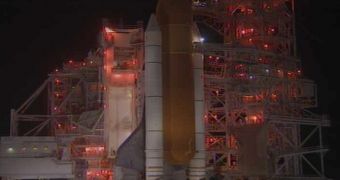Officials at the American space agency announce that the space shuttle Discovery is currently undergoing final preparations for its roll off the launch pad, and back into a processing facility.
Discovery, originally scheduled to take off on its final trip to space ever in early November, has been on the Launch Pad 39A since, at the Kennedy Space Center (KSC), in Cape Canaveral, Florida.
But mission planners and controllers have decided to try and launch the shuttle no earlier than February 2011, and they can't leave it there for at least another month, hence the roll off maneuver.
The process will begin today, December 21, at 12:30 am EST (1730 GMT), when the mobile launch platform on which the orbiter is placed will begin its slow drive to the Vehicle Assembly Building.
The VAB is a massive structure at the KSC, where space shuttles are usually mated with their external fuel tanks and twin solid rocket boosters (SRB). That is where Discovery will spend the holiday season.
Engineers would have moved discovery out of the launch pad earlier on, but they first had to conduct a tanking test on December 17, to ensure that all of the cracks in the EFT had been covered.
After the shuttle is returned to the VAB, its massive fuel tank will be inspected again with renewed caution, as experts are trying to track down all areas that might pose a problem to the February launch.
If the EFT is cleared, then experts will move to reapply the insulating foam that usually covers the massive structure, and will give their go-ahead for the mission's launch, a NASA press release says.
At this point, the tank still has numerous sensors attached to its foam and aluminum surface. They were attached so that mission scientists could keep a close eye on how the tank handled during the December 17 test.
“The sensors were used to measure changes in the tank as super-cold propellants were pumped in and drained out during the test,” experts at the agency say in the new document.
“Data and analysis from the test will be used to determine what caused the tops of two, 21-foot-long support beams, called stringers, on the outside of the intertank to crack during fueling on Nov. 5,” the document goes on to say.
During Discovery's STS-133 mission, the orbiter was supposed to launch to the International Space Station (ISS) and spend between 11 and 13 days there. This is the last planned flight for the shuttle.
It carries the Robonaut 2 humanoid robot, which was developed by NASA and General Motors, as well as a permanent storage facility, the Multipurpose Logistics Module (MPLM).

 14 DAY TRIAL //
14 DAY TRIAL //